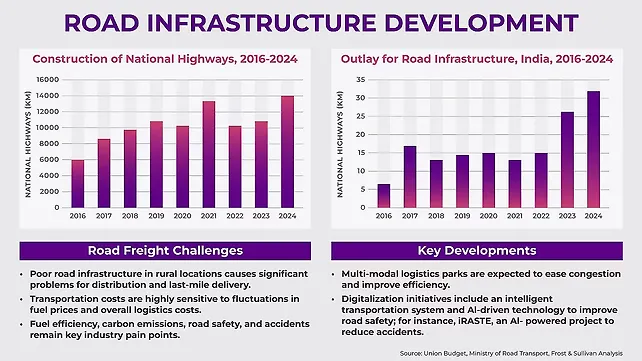
India’s roads cover a total distance of 6.34 million km and is one of the largest road structures in the world. With almost 65% of total goods being delivered by road, India ranks second in terms of road networks globally.
Expanding at a rate of about 38 km a day in 2022, 2023 is expected to see a higher rate of road expansion in the country due to a lower road-per-person penetration. With a low penetration of 5.1 km of roads per 1,000 people compared to the United States, which has 20.5 km of roads per 1,000 people, it highlights the wide scope for road development and expansion in India.
The movement toward this development was initiated by the government with projects for national highways, state highways, major district roads, expressways, and rural area roads. Private sector investments are also encouraged by the Indian government through various policies like the hybrid-annuity model and toll-operate transfer model, which provide benefits of monetisation and have sparked an interest in the private sector.
Financial assistance is also provided by the Ministry of Road Transport & Highways (MoRTH) through its Central Road Infrastructure Fund (CRIF) initiative for the construction of state roadways.
Broad Steps Toward Strengthening Road Infrastructure
While the MoRTH oversees the development and maintenance of national highways, state governments are responsible for roadways in their respective territories that are not national highways. As the government lays out projects for establishing a number of significant programmes for national highways, expressways and road connectivity across the nation, road freight has gained a strong foothold in the country.
The diversified demographic of customers and businesses depends heavily on the nation’s road infrastructure, especially for last-mile connectivity to urban, rural, and remote areas of India.
Major road infrastructure initiatives by the Government of India include:
Bharatmala Pariyojana: This initiative aims to build a strong network of roads, expressways, and highways across India. This project assigned the development of 34,800 km for phase 1, with an allocated budget of $ 76.55 billion for 2018 to 2022. The project also includes integrated infrastructure development, consisting of 22 greenfield corridor developments, with a combined length of 8,409 km.
Pradhan Mantri Gati Shakti – National Master Plan for Multi-modal Connectivity: This initiative focuses on developing a system for interconnected and integrated multi-modal transportation networks, which includes improving connectivity in road freight transport through the development of 39 multi-modal logistics parks to ease congestion in choke points.
NHIDCL (National Highways & Infrastructure Development Corporation Limited): Under Bharatmala Pariyojana Phase I, the NHIDCL has been assigned to develop 5,070 km of roads. This project will improve connectivity among border highways and the economic corridor.
Special Accelerated Road Development Programme for North Eastern region (SARDP-NE): This project mainly focuses on the development of the North-Eastern region road infrastructure. SARDP-NE Phase B will construct 3,723 km of roads, which consist of 2,210 km of national highways and 1,513 km of state roads by 2023-24.
Arunachal Pradesh Scheme: This project aims to be complete by 2023-24 and will develop 2,205 km of national highways and 114 km of state roads.

Increasing Budget Allocations Will Lay The Path For Future Development
With the government rolling out projects for road development, budget allocations have seen a rising trend. Amid the growing cost of borrowing and escalating land acquisition prices, the prospects of the Indian road infrastructure will remain bright with a higher budget allocation to this sector ($32 billion for 2024).
The road Infrastructure budget is dedicated to various programmes for the development of road freight and connectivity among the states. The union budget (2023-24) has increased the budget for road infrastructure to 24%, which will help India grow economically and strengthen connectivity. Nearly 60% of the outlay has been allocated to the National Highways Authority of India to increase national highways by 14,000 km during FY24, and 39% is allocated for other categories of road infrastructure projects.
Better Road Infrastructure Will Support Seamless Road Freight Movement
India’s road infrastructure has a bright future, and the government has strived diligently to find new solutions and boost the transportation infrastructure and connectivity. Between 2023 and 2030, the demand for freight transportation services will rise in pace with economic expansion.
Road transport will continue to be the key mode of land transportation, and despite improvements in rail freight development projects, the proportion of road freight is anticipated to remain between 65-70%. Due to smaller trucks’ access to distant fulfilment centres, the growing demand for road freight from industries like retail, fast-moving consumer goods, and e-commerce is anticipated to increase.
The government is focusing on renewable energy solutions and prioritising development of electric vehicles to reduce carbon emissions, and also help companies lower transport costs. Real-time cargo tracking, cargo condition monitoring, computer vision, and telematics are some of the digital technologies likely to see increased adoption trends, facilitating the seamless movement of freight.
Road freight transportation is expected to offer opportunities due to an increased focus on multi-modal connectivity, a growing demand for e-commerce deliveries, and higher volume from the fast-moving consumer goods (FMCG) sector.
About the Author: TJ Sivan is Senior Consultant, Supply Chain & Logistics Practice at Frost & Sullivan.
Also Watch
This Is What Makes Delhi-Mumbai Expressway Special
Key MoRTH Initiatives, Mandates In 2021 Augur Well For Future
NHAI Makes Monthly Drone Survey Mandatory For All National Highway Projects